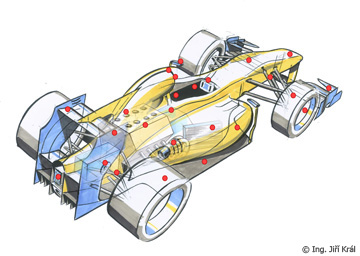The Hungarian Games Haas F1 Team Has Odds Ever in its Favor with Run of Points-Paying Finishes
Mike Arning/HAAS F1 | 24.7.18 | Aktuality
HAAS F1 2018
The Hungarian Games
Haas F1 Team Has Odds Ever in its Favor with Run of Points-Paying Finishes
KANNAPOLIS, North Carolina (July 24, 2018) – Trivia question: Outside of Scuderia Ferrari, Mercedes and Red Bull, what Formula One team has scored the most points in the last five races? Answer: Haas F1 Team.
The American organization, in just its third year competing in the FIA Formula One World Championship, has scored 40 points in the last four races, more than any midfield team dating back to the June 10 Canadian Grand Prix – a run of five races.
While Haas F1 Team didn’t score any points in its visit to Montreal, it did bring significant updates to its racecars. A new front wing and floor joined a revised bargeboard area on the Haas VF-18s of drivers Romain Grosjean and Kevin Magnussen. In lieu of points, Haas F1 Team found potential, as both Grosjean and Magnussen were buoyed by the knowledge that these updates would perform even better on power tracks, which comprised the mid-summer stretch of the French, Austrian, British and German Grands Prix.
Their respective intuition proved spot on. Both drivers made it to the final round of qualifying in each grand prix, and both proved quick in the races, albeit with different results. Magnussen scored the first points in France with a sixth-place finish, which was a prelude to Haas F1 Team’s best performance to date – a double-points result in Austria where Grosjean finished fourth and Magnussen came home fifth. Magnussen grabbed ninth the next week at Silverstone to pick up two more points, while Grosjean rallied from 10th to sixth in the final 10 laps in the series’ most recent race in Germany to score another eight points.
That last result brought more than points, however. There was worry coming into the German Grand Prix that the Hockenheimring’s array of tight corners would prove slightly troublesome for the Haas VF-18, as it is better suited for high-speed corners. But come Friday in practice, Grosjean and Magnussen found they had the same speed at Hockenheim as they had in the previous grands prix in France, Austria and England. The compact turns of the Hockenheimring, specifically in the Motordrom section, did not compromise the performance of the Haas VF-18s.
That was good for obvious reasons, but it also gave Haas F1 Team confidence leading into Sunday’s Hungarian Grand Prix. The 4.381-kilometer (2.722-mile), 14-turn Hungaroring is a tight circuit that many drivers liken to a full-size karting track. It is the slowest permanent venue in Formula One, a juxtaposition from the recent run of power circuits.
Slow, however, doesn’t mean easy. Despite an average speed of 200 kph (124 mph), which is notably slower than the average speed drivers normally experience in Formula One, the Hungaroring requires precision and preservation. It is a physical track, demanding a lot from the drivers who, in turn, demand a lot from their car throughout the 70-lap race.




